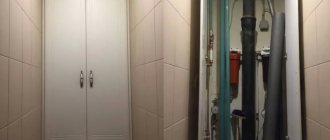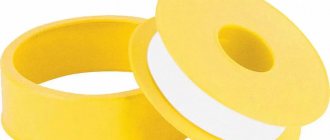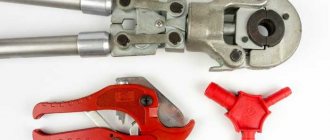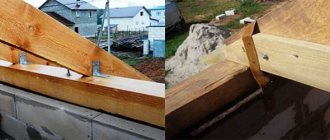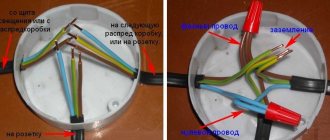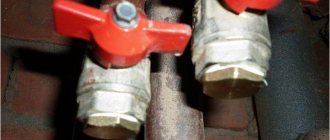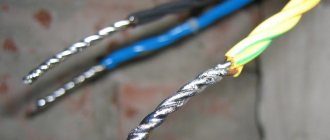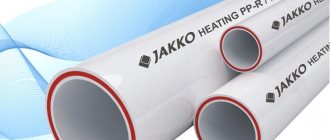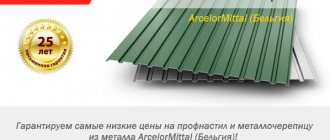Copper pipe products have long been considered a universal solution.
They are used everywhere: when laying water pipes, gas pipelines and heating mains. These products are not affected by chlorinated water, and this becomes an important factor when choosing them for work.
They are the best option for laying a city water main. After all, copper areas are not affected by corrosion and serve for a long time.
Laying a main line from such pipes is carried out using various connection options. These are: soldering and welding, as well as using fittings for copper pipes for crimping.
Pros and cons of these parts
Connecting pipelines with crimp fittings is very easy. With this method, you do not need to use high temperature or use special equipment.
This is how pipes are laid even in places of difficult access. This work requires the following tools:
- Wrench;
- Calibrator;
- Cutter.
If you compare the time and labor costs for this work, they are small. And the laid pipeline comes out sealed and lasts for a long time.
But, no matter how good such a system is, it still has drawbacks. The crimp fitting must be constantly checked and tightened. For this reason, they are not recommended to be laid under concrete.
And these parts are also designed to operate the system with low pressure. If we compare their reliability with soldering, then these fittings have less reliability.
The connection, mounted with compression fittings, becomes a structure that is used repeatedly.
It can be assembled and disassembled. But, each subsequent installation and dismantling will affect its strength.
Tools required for crimping
Do not use a hammer, chisel or pliers. They damage the protective shell, which leads to a decrease in the quality of contact.
Press jaws
A hand-held mechanical tool that ensures reliable connection of wires using a metal tube. It is similar to pliers, but is equipped with raised dies. The device is intended for household and industrial use. The device has a ratcheting mechanism: the handles will not open until the crimping is completed completely.
The pliers have long handles, which makes crimping easier. The tools can be diaphragm or operating on the principle of pliers. The second type performs crimping from 2 sides. The first provides 4- or 6-way crimping. You can also use a hydraulic crimper.
Sleeves
Operation requires copper, aluminum or combined tubes of a given diameter. Their number depends on how many connections need to be made.
Tubes of a given diameter are required for operation.
Heat shrinkable tubes
Heat shrinks are plastic tubes needed to insulate the bond of electrical wires. They have thermoplasticity. During the heating process, the material acquires a liquid form, and during cooling it turns into a stretchable mass and hardens. The joint area becomes protected from mechanical damage. The insulating properties are not reduced even under the influence of external negative factors.
Construction hair dryer
The tool is designed for heating heat-shrinkable insulating materials. To do this, it is enough to use household models of low power.
How a crimp fitting works and works
This device includes:
- Frame;
- Compression nut;
- Crimping ring. Often one or two rings are placed. They increase the tightness of the joint and provide resistance to high pressures. This also extends the life of the structure.
IMPORTANT! It is recommended to purchase parts in which the seal is not simple rubber, but EPD M. Such products will last longer.
To produce these elements the following is used:
- Brass;
- Copper;
- Plastic;
- Metal.
For copper pipe products, brass fittings are most often used. They are easy to process and have a low cost when compared to copper products.
And the strength of brass is equal to stainless steel, and it fits much easier. To increase the stability of brass fittings, they are plated with nickel.
When purchasing such parts, you need to take into account their weight (do not take light items). Experts also recommend purchasing them from a reputable manufacturer.
This way, finances will not be wasted, and the highway will operate smoothly and reliably.
Curious facts
Finally, a few educational facts about copper pipes.
Due to the high thermal conductivity of copper, the cold water supply system collects a large amount of condensate in the summer . The problem is solved by thermal insulation or using a pipe in a polyethylene sheath.
Copper in a heat-insulating shell.
Thermal insulation will slow down the cooling of hot water in the water supply and reduce unnecessary heat loss on the surface of risers and heating lines.
All copper water pipes are seamless . Production equipment includes a melting furnace, casting apparatus, rolling mill and pipe drawing mill.
Copper is a conductor with very low electrical resistance . If one of your neighbors used the water supply to ground household appliances, you risk finding out about it in the most unpleasant way.
The low electrical resistance of copper is very clearly demonstrated by an experiment that requires a copper pipe and a magnet (preferably neodymium). If you throw any heavy object into a vertical tube, it will fall to the floor in full accordance with the laws describing free fall. But a neodymium magnet spun around its own axis before being thrown in a copper pipe will fall down for a good ten seconds.
Experiment with a magnet and a copper ring conductor.
Why?
The fact is that the passage of a magnetic field through a ring conductor with low resistance induces eddy currents in it. They, in turn, generate a secondary magnetic field. The interaction of the magnet’s own field and the field induced in the copper conductor provides the effect of magnetic levitation observed in this experiment.
The induced field interacts with the magnet's own field.
Types of crimp fittings
Video
Copper fittings
These devices come in the following types:
- Tee. For installation of branches in one direction;
- Cross. For a branch device in two directions;
- Clutch. Used to connect pipe blanks that have the same diameters;
- Retraction. Apply to create a turn;
- Stub. Placed on the end of the cut piece.
For the joint of pipes that have the same diameters, straight parts are used, and for different diameters a transitional option is used.
By type they are divided into:
- Threaded;
- Compression;
- Capillary;
- Press fittings;
- Self-locking.
Three main connection methods
Before connecting sections of copper pipes, they must be cut in accordance with the wiring diagram and prepared. You will need a pipe cutter or hacksaw, a pipe bender and a file. And for cleaning the ends, fine-grained sandpaper will not hurt.
Only having a diagram of the future pipeline system in hand can you calculate the required amount of consumables. It is necessary to decide in advance where and what diameter the pipes will be installed. It is also necessary to clearly understand how many connecting elements are required for this.
Option #1: Welding copper pipes
To perform automated or manual welding of copper pipes, electrodes and gas are required to create a protective environment (nitrogen, argon or helium). You will also need a DC welding machine and, in some cases, a torch. The electrode can be graphite, tungsten, copper or carbon.
The main disadvantage of this installation technology is the significant differences in the characteristics of the resulting seam and the pipe metal. They differ in chemical composition, internal structure, electrical and thermal conductivity. If welding is performed incorrectly, the joint may even separate later.
Due to the alloying of copper as a result of the action of the deoxidizer present in the electrode, the weld seam is in many respects very different from the base metal being welded
Only a qualified craftsman can properly weld copper pipes. This requires certain knowledge and skills.
This installation option has a lot of technological nuances. If you plan to do everything yourself, but have no experience working with a welding machine, then it is better to use a different connection method.
Option #2: Capillary soldering
In domestic conditions, copper pipes are rarely connected by welding plumbing fixtures. It is too complex, requires specialized skills and is time consuming. It is easier to use the capillary soldering method using a gas torch or blowtorch.
The technology of soldering copper pipes with solder is based on the capillary rise (seepage) of the latter after melting along the gap between two pressed metal planes
Soldering of copper pipes happens:
- low temperature - soft solders and a blowtorch are used;
- high temperature - refractory alloys and a propane or acetylene torch are used.
These methods of soldering copper pipes do not make much difference in the final result. The connection in both cases is reliable and tear-resistant. The seam with the high-temperature method is somewhat stronger. However, due to the high temperature of the gas stream from the burner, the risk of burning through the metal of the pipe wall increases.
Solders are used based on tin or lead with the addition of bismuth, selenium, copper and silver. However, if pipes are soldered for a drinking water supply system, then it is better to avoid the lead option due to its toxicity.
Image gallery
To implement low-temperature welding, it is not necessary to have special equipment and special skills of the performer. You can do it yourself
Threaded elements
They are simple and durable, their design does not require modification. The best option for these parts are brass fittings. They are characterized by increased resistance to corrosion, and are installed in those places of the pipeline where fixation to the wall is required.
IMPORTANT! It is not recommended to combine such fittings with pipelines made of plastic, metal-plastic and copper. Because during twisting, this part can easily crush the workpiece made from the specified materials.
Instructions for crimping
Proper selection of metal tubes is required to maintain electromechanical coupling.
Preparation
Preparation for crimping involves the following actions:
- Selection of appropriate sleeves and dies for press jaws.
- Removing the insulating sheath from the wire by 2–3 cm (no more than the length of the sleeve itself).
- Cleaning bare areas with fine-grain sandpaper.
- Treatment of aluminum cores with quartz-vaseline paste. It will protect the metal from damage and oxidation.
Preparation for crimping involves selecting appropriate sleeves.
Copper wires do not need to be lubricated.
Crimping process step by step
The procedure is performed according to the following instructions:
- If the crimping is one-sided, then the conductors are placed inside the tube parallel to each other. In double-sided processing, the cores are inserted into the sleeve from opposite sides. You cannot twist them together.
- The connection is processed using press tongs using local indentation.
After completing the procedure, the clutch area is wiped with a solvent (for degreasing).
Crimping of wires with GSI sleeves
Wire insulation
Insulation requires electrical tape or heat shrink. The second one is better. The tube is placed on one of the wires before crimping. After the connection is formed, it is moved to the desired area and heated with a construction hairdryer. After cooling, the heat shrink shrinks and tightens around the joint, making it resistant to external negative influences.
Heat shrink is used to insulate the wires.
Compression
Situations arise when it is not possible to use open fire, then compression fittings are installed on copper pipelines. They allow you to easily work with workpieces of unequal diameters, and the material may be different.
They come from:
- brass;
- copper;
- metal-plastic;
- plastic;
- become.
They have a crimp ring; it secures the part to the pipe and creates a fairly airtight joint. This ring is tightened manually using a wrench and a connection nut.
IMPORTANT! It is very convenient to work with these elements in areas with difficult access.
Installation
During installation, the nut is connected to the fitting, then the thread is tightened - first by hand, then with a wrench. If joining with pipes made of other materials cannot be avoided, fum tape will come to the rescue, which is screwed onto the threaded part under the fitting.
If you do not want to accelerate the corrosion processes in the connection, do not use a transition from copper to galvanized or unalloyed steel. Electrochemical processes occurring between these metals can reduce the service life of the pipeline.
Capillary connection elements
They are more suitable than others for pipe products made of copper and steel. On the inside, under the cut thread, they have a very thin wire made of copper, tin, or silver. This wire becomes the solder.
Video
Pressing copper pipes. Water, gas.
The workpiece, which is coated with flux, is inserted into the fitting. The joint is heated with a burner. Heating is carried out until the molten solder fills the space.
After this, the joint is left to cool. After some time, the joint area is cleaned with special cleaning agents for working with copper.
The described connection is considered the most reliable, and for copper products it is better suited than others.
Where to apply?
Copper pipes with threaded fittings are highly competitive, despite the fact that many other types of connections and materials for the manufacture of pipelines have appeared in the world. And all thanks to the almost magical properties of copper - disinfection of water when transmitted through pipes, the pipe itself does not oxidize, does not rust, products made from it are very reliable, but at the same time plastic, characterized by resistance to changes and temperature fluctuations from high to low.
Where is the scope of application of copper pipes?
Believe me, everywhere! These lightweight and durable pipes have a place in the design and installation of air ducts, and the crimp type of copper fittings is actively used in communication networks. Wherever you find a copper pipe - in heating systems and appliances, in air conditioners, in gas devices and pipelines, in the water system - copper is always present. Some experimenters use copper pipes as a decorative or interior element - they take any shape and can be connected to any other pipe (and not only), and are interesting for their unique color and shine.
Self-locking connectors
Video
Copper pipe rolling
Self-locking elements are mechanical type devices. It is based on inner rings, and one of these rings has teeth. When pressed with a puller key, they fit tightly into the other ring.
This type of joint is reliable and durable. This part can be used more than once, because with the help of a puller key, it is very easily removed.
This type of fitting is made from copper, and it perfectly holds workpieces of any type of cross-section and different materials together. This is a very convenient way for a pipeline made of various pipe products and fittings.
Rules for crimping wires
Crimping of wires with sleeves is carried out taking into account the following rules:
- The materials used to make the tube and conductors must match each other.
- Crimping elements cannot be shortened by sawing. In this case, the protective layer is damaged and the contact reliability is reduced.
- To carry out the crimping procedure, a special tool is required - press pliers.
Crimping of wires is done with a special tool.
The cross-section of the wires cannot be reduced so that they fit into the sleeve. It is better to take a larger diameter crimping element
How to install crimp fittings on a copper pipe
Video
Radial presses for crimping fittings
It should be noted right away that this type of connection does not require special equipment, and you can make it yourself.
According to European standards, crimp connectors are divided into two types and are marked with the letter A or B.
Type A. Used exclusively for laying above-ground pipeline networks made from semi-solid copper or stainless steel.
Type B. It is used for above-ground and underground communication systems, created from soft and semi-hard types of copper with thick-walled pipes.
IMPORTANT! To get a very reliable joint, you must act strictly according to certain rules and instructions.
How to install fittings for type A crimp:
Video
Pressing copper pipes is quick and easy! (4)
- An element of the required size is selected. This is easy to do because all connecting structures are produced according to the same European standard;
- A pipe blank of the required size is cut and the burrs are removed. The sections are checked with a gauge. Contamination is removed from the workpiece, poorly processed edges and damage are cleaned. A crimp ring is placed on the workpiece.
ADVICE. It is recommended to wet the joint with water, this will prevent the seal from slipping and breaking;
- The end of the pipe is inserted into the connector until it stops. After this, the clamping nut is tightened. First they twist it by hand, and then take a wrench.
ADVICE. There is no need to apply excessive force during these actions. This will not improve the tightness of the connection. If cheap parts are used for work, then there is a risk of extruding the ring, and then the joint will not be reliable.
After such work, the pipe may be slightly deformed. This will confirm that the connection is made airtight.
How to install type B compression fittings
Video
Copper pipes (installation, soldering)
This type of crimp connection elements is mounted in almost the same way as in the first case. The cutting area is thoroughly cleaned of dirt. The thread should also be free of dirt. Only light lubrication of the threads with machine oil is allowed.
This will make it easier to wrap the pipe. It is necessary to ensure that the seal cone is pressed against the inside of the workpiece, and the edge of the workpiece itself must be flared.
You need to choose the right key. It should not become loose; this will damage the nut. For example, for a diameter of 54 mm, you will need a 750 mm wrench.
Features of connecting these fittings to pipes
Video
The cost of a line made of copper pipes is high, so when purchasing materials it is advised to follow the following rules:
- It is necessary to give preference to homogeneous materials, so the entire structure will last longer;
- Do not combine copper and unalloyed steel. Electrochemical processes between them have a detrimental effect on the connection. In this case, the steel elements become covered with rust;
- If it is impossible to do without using dissimilar materials, then steel products are mounted in front of copper ones in the direction of fluid movement;
- Copper pipes go well with their PVC network elements. There are no negative consequences in this situation.
The essence of crimping
The use of standard connection methods can lead to fraying or destruction of stranded conductors. In this case, their functionality is limited. As a result, the fixation areas become very hot and burn out. Copper wiring oxidizes over time and loses its quality. Connection reliability suffers.
The sleeve prevents air from entering the clutch. The wire strands are placed into the tube from opposite ends, after which it is processed with press pliers. Crimping is carried out at 2–3 points. In these places, the materials being connected are deformed along with the tube. After crimping, the area is isolated.
Briefly about the main thing
Plastic pipes are made from three types of raw materials: polyethylene, polypropylene, polyvinyl chloride. Metal ones are made mainly from steel and copper, cast iron is less often used. Polypropylene and steel are most often used to install a heating system or water supply.
There are a number of ways to connect pipes made of different materials: using fittings, Gebo fasteners, flanges, clip lining, crab fasteners or clamps. Welding is only suitable for joining homogeneous materials, but if a metal tip is put on a plastic pipe, then this method can also be used.
All of the methods listed are not homemade and the components for their use are freely available. The main thing is to understand the system itself and purchase the necessary fasteners of the appropriate size.
When you have to connect plastic and metal pipes
Metal and plastic are combined in several situations:
- The heating boiler has a metal outlet pipe. If the heating system pipes are plastic, then different materials will need to be joined. Usually a splitter is installed in this place.
- If the house has central water supply and heating, then the likelihood of simultaneous major repairs of external and internal pipes is almost zero.
- If part of the highway being laid is subject to increased mechanical and temperature loads, then this section of the route can be made of metal pipes.
- If technological equipment with plastic leads crashes into the system.
